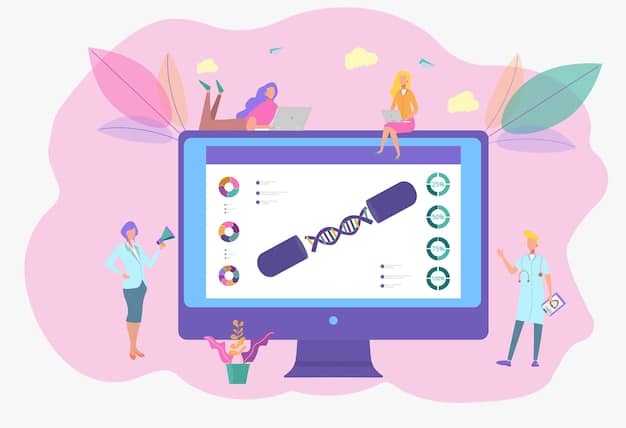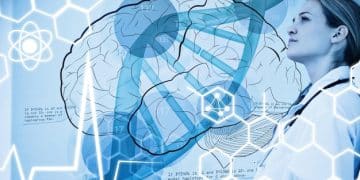CRISPR Gene Editing in the US: Risks, Benefits, and Ethical Concerns

CRISPR gene editing technology in the US offers potential benefits such as treating genetic diseases and improving agriculture, but it also raises risks including off-target effects, ethical dilemmas, and regulatory challenges.
The advent of CRISPR gene editing technology in the US has opened unprecedented possibilities in medicine and agriculture. But with great power comes great responsibility; this groundbreaking tool also introduces complex ethical considerations and potential risks that demand careful examination.
Understanding CRISPR Gene Editing: A Primer
CRISPR-Cas9, often referred to simply as CRISPR, is a revolutionary gene editing technology that allows scientists to precisely alter DNA sequences within living organisms. This tool has rapidly transformed fields ranging from medicine to agriculture, offering potential solutions to previously intractable problems.
But what exactly is CRISPR, and how does it work? Let’s delve into the basics of this groundbreaking technology.
How CRISPR Works
CRISPR is derived from a naturally occurring defense mechanism used by bacteria to protect themselves from viral infections. Scientists have adapted this system to create a versatile gene editing tool that can be programmed to target specific DNA sequences.
The CRISPR system consists of two key components: the Cas9 enzyme, which acts like a pair of molecular scissors, and a guide RNA molecule, which directs the Cas9 enzyme to the precise location in the genome that needs to be edited.
- Targeting: The guide RNA is designed to match the DNA sequence that scientists want to modify.
- Cutting: Once the guide RNA finds its target, the Cas9 enzyme cuts the DNA at that location.
- Repair: The cell’s natural repair mechanisms then kick in to fix the break in the DNA. Scientists can manipulate this repair process to either disrupt a gene or insert a new one.
Understanding the mechanics of CRISPR is essential for grasping both its potential and its risks. The precision of this technology is what makes it so powerful, but it also means that any errors in targeting or repair can have unintended consequences.
Potential Benefits of CRISPR in the US
CRISPR technology holds immense promise for addressing some of the most pressing challenges in healthcare and agriculture. In the United States, researchers are exploring a wide range of applications that could revolutionize these sectors.
Let’s explore some of the most significant potential benefits that CRISPR offers.

Treating Genetic Diseases
One of the most exciting applications of CRISPR is its potential to treat genetic diseases. Many diseases, such as cystic fibrosis, Huntington’s disease, and sickle cell anemia, are caused by mutations in a single gene. CRISPR offers a way to correct these mutations and potentially cure these diseases.
Clinical trials are already underway in the US to test the effectiveness of CRISPR in treating certain genetic disorders. These trials represent a significant step forward in the development of gene-based therapies.
Enhancing Agriculture
CRISPR can also be used to improve crop yields, enhance nutritional content, and develop crops that are more resistant to pests and diseases. This is particularly important in the US, where agriculture plays a vital role in the economy.
By using CRISPR, scientists can make precise changes to the genes of plants, without introducing foreign DNA. This can lead to the development of crops that are more sustainable and require fewer resources.
- Increased Yields: CRISPR can be used to enhance the growth and productivity of crops.
- Pest Resistance: CRISPR can create crops naturally resistant to pests, reducing the need for pesticides.
- Improved Nutrition: CRISPR can enhance the nutritional value of crops, making them richer in vitamins and minerals.
The potential for CRISPR to transform agriculture is vast, and ongoing research in the US is focused on realizing these benefits while also addressing potential environmental concerns.
In conclusion, CRISPR technology offers a multitude of potential benefits in the US, from treating genetic diseases to improving agricultural practices, enhancing food production efficiency, and contributing to global food security.
Potential Risks and Ethical Concerns
While the potential benefits of CRISPR are significant, it’s equally important to consider the potential risks and ethical concerns associated with this technology. The ability to edit genes raises profound questions about the future of human health and the environment.
Let’s examine some of the key risks and ethical dilemmas that need to be addressed.
Off-Target Effects
One of the primary concerns with CRISPR is the possibility of off-target effects. This occurs when the Cas9 enzyme cuts DNA at locations other than the intended target. These unintended edits can have unpredictable and potentially harmful consequences.
Researchers are working to improve the precision of CRISPR and minimize off-target effects. However, the risk remains a significant challenge.
Germline Editing
Germline editing involves making changes to the DNA of sperm, eggs, or embryos. These changes would be passed down to future generations, raising ethical concerns about the potential for unintended consequences and the alteration of the human gene pool.
Currently, germline editing is prohibited in many countries, including the US. However, the debate over whether to allow germline editing for therapeutic purposes continues.
- Ethical Concerns: Altering the human germline raises concerns about informed consent, equitable access, and the potential for unforeseen health consequences.
- Long-Term Effects: The long-term effects of germline editing on future generations are unknown.
- Social Justice: There are concerns that germline editing could exacerbate existing social inequalities.
The ethical implications of germline editing are profound and require careful consideration. It’s essential to engage in a broad public dialogue to determine how to proceed responsibly.

Overall, while CRISPR offers incredible potential, it also introduces significant risks and ethical challenges. Careful research, robust regulation, and ongoing public dialogue are essential to ensure that this technology is used responsibly and ethically in the US.
Regulatory Landscape in the US
Given the potential risks and benefits of CRISPR technology, the regulatory landscape in the United States is complex and evolving. Various government agencies have jurisdiction over different aspects of CRISPR research and development, leading to a multifaceted regulatory framework.
Understanding this framework is crucial for researchers, companies, and policymakers alike.
FDA Oversight
The Food and Drug Administration (FDA) has primary responsibility for regulating gene-edited products intended for human use. This includes therapies for genetic diseases and other medical applications.
The FDA evaluates the safety and efficacy of CRISPR-based therapies through clinical trials and a rigorous approval process. The agency also has the authority to regulate the manufacturing and labeling of these products.
USDA Regulations
The United States Department of Agriculture (USDA) regulates gene-edited crops and other agricultural products. However, the USDA’s approach to regulating CRISPR-edited crops has been more lenient than that of the FDA.
The USDA generally does not regulate crops that have been edited using CRISPR if the changes could have been achieved through traditional breeding methods. This approach has been praised by some as promoting innovation, but it has also raised concerns about transparency and environmental safety.
- Transparency: There is ongoing debate about whether CRISPR-edited crops should be labeled to inform consumers about the technology used to produce them.
- Environmental Impact: Some environmental groups have raised concerns about the potential impact of CRISPR-edited crops on biodiversity and ecosystems.
The regulatory landscape for CRISPR in the US is still evolving, and ongoing discussions are focused on striking the right balance between promoting innovation and protecting public health and the environment.
Balancing oversight to promote innovation while safeguarding against potential risks is a complex challenge, necessitating ongoing dialogue among stakeholders to refine and adapt regulations as our understanding of CRISPR evolves.
Public Perception and Education
The successful and responsible implementation of CRISPR technology in the US depends not only on sound regulation but also on public understanding and acceptance. Public perception of CRISPR is shaped by a variety of factors, including media coverage, scientific literacy, and cultural values.
Education plays a crucial role in fostering informed public discourse and decision-making.
Addressing Misconceptions
One of the challenges in communicating about CRISPR is addressing common misconceptions and fears. Many people are unfamiliar with the technology and may be concerned about its potential for misuse.
Effective communication strategies are needed to explain the science behind CRISPR in a clear and accessible way. It’s also important to address ethical concerns and emphasize the potential benefits of the technology.
Engaging the Public
Engaging the public in a dialogue about CRISPR is essential for building trust and ensuring that the technology is used in a way that reflects societal values. This can involve town hall meetings, public forums, educational programs, and online resources.
By involving the public in the decision-making process, policymakers can ensure that CRISPR is used responsibly and ethically.
- Transparency: Openness and transparency are crucial for building public trust.
- Stakeholder Involvement: Involving a wide range of stakeholders, including scientists, ethicists, policymakers, and the public, is essential for informed decision-making.
Ultimately, the successful integration of CRISPR technology into American society will depend on fostering a well-informed and engaged public. Through education, dialogue, and transparent communication, we can ensure that the technology is used in a way that benefits all of society.
Public sentiment significantly influences the trajectory of technological integration; proactive educational initiatives can help bridge understanding and promote informed dialogue, ensuring that societal values are integrated into the ethical implementation of CRISPR technology.
The Future of CRISPR in the US
The future of CRISPR gene editing technology in the US is filled with both promise and uncertainty. As research progresses and the technology becomes more refined, it’s likely that we will see an expansion of CRISPR applications in medicine, agriculture, and other fields.
However, the path forward will depend on addressing the ethical, regulatory, and social challenges that CRISPR presents.
Ongoing Research and Development
Scientists are continually working to improve the precision and efficiency of CRISPR. This includes developing new versions of the Cas9 enzyme, refining delivery methods, and exploring new applications of the technology.
Ongoing research is also focused on better understanding the potential risks of CRISPR and how to mitigate them.
Ethical Frameworks
The development of ethical frameworks for CRISPR is essential for guiding its responsible use. These frameworks should address issues such as informed consent, equitable access, and the potential for unintended consequences.
Ethical frameworks should also be regularly updated to reflect new scientific developments and societal values.
- Collaboration: Collaboration among scientists, ethicists, policymakers, and the public is essential for developing effective ethical frameworks.
- Adaptability: Ethical frameworks should be adaptable to new scientific developments and societal values.
The future of CRISPR in the US will depend on our ability to navigate the complex ethical, regulatory, and social challenges that it presents. By fostering a culture of responsible innovation, we can harness the power of CRISPR to improve human health and the environment.
The successful integration of CRISPR hinges on collaborative efforts, with researchers, policymakers, and the public collectively stewarding its direction to maximize benefits while upholding ethical considerations and minimizing risks.
| Key Point | Brief Description |
|---|---|
| 🧬 Genetic Disease Treatment | CRISPR can correct genetic mutations, potentially curing diseases. |
| 🌱 Agricultural Enhancement | CRISPR improves crop yields, pest resistance, and nutritional value. |
| ⚠️ Off-Target Effects | Unintended edits to DNA can have harmful consequences. |
| 🤔 Ethical Concerns | Germline editing and equitable access raise significant ethical questions. |
[Frequently Asked Questions]
▼
CRISPR-Cas9 is a gene editing technology that allows scientists to precisely alter DNA sequences in living organisms. It derived from bacterial defense mechanisms and has revolutionized genetic research.
▼
CRISPR offers the potential to treat or cure genetic diseases by correcting mutations in genes. It is also being explored for cancer therapy and infectious disease treatment.
▼
Yes, ethical concerns include the potential for off-target effects, germline editing (altering DNA passed to future generations), and equitable access to these technologies.
▼
In the US, the FDA regulates CRISPR-based therapies for human use, ensuring safety and efficacy. The USDA regulates gene-edited crops, with a more lenient approach if changes are achievable through traditional breeding.
▼
CRISPR can enhance crop yields, improve nutritional content, and create resistance to pests and diseases, leading to more productive and sustainable agricultural practices.
Conclusion
In conclusion, CRISPR gene editing technology in the US holds tremendous potential for advancing medicine and agriculture, but it also presents significant risks and ethical considerations. A balanced approach involving careful research, robust regulation, and ongoing public dialogue is essential to ensure that this powerful tool is used responsibly and ethically for the benefit of society.





